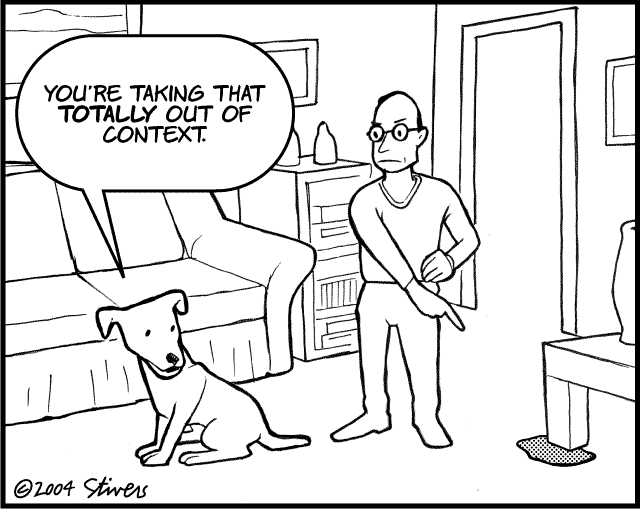Movie buffs may recall the scene from Four Weddings and a Funeral in which Tom, as best man, gives the speech:
Tom: When Bernard told me he was getting engaged to Lydia, I congratulated him because all his other girlfriends were such complete dogs. Although may I say how delighted we are to have so many of them here this evening. I’m particularly delighted to see Camilla, who many of you will remember as the first person Bernard asked to marry him. If I remember rightly, she told him to sod off. And lucky for Lydia that she did…
Sensitivity to Context can be viewed as the outer-directed version of the Self-Awareness dimension as described by Richard Davidson in The Emotional Life of Your Brain. Those at the Tuned-Out end, such as Tom, are oblivious to rules that govern social interactions. They fail to distinguish what might be perfectly acceptable in one context is offensive in another. While humorous in this example, when accompanied by extreme anxiety it can lead to an inability to distinguish safe situations from dangerous ones, a risk for Post Traumatic Stress Disorder (PTSD).
Those at the Tuned In extreme have their own issues. They can become emotionally paralyzed by minutely parsing every nuance of the social environment, and become a chameleon – a different person in every situation, losing touch with who they actually are.
What’s Happening in the Brain? The hippocampus seems to play a crucial part in comprehending context. High activity in the hippocampus is characteristic of Tuned In and low activity for Tuned Out.
The hippocampus and the amygdala are both are involved with memory, and ideally have a good partnership. The amygdala is a generalist, and is triggered by intense emotional states like fear. It assigns emotional intensity to incoming information. The hippocampus looks after explicit memory (facts, dates, words – pieces of information), so provides context for our memories.
In stressful situations, our bodies release a lot of cortisol. The hippocampus has many cortisol receptors, so when stress is prolonged, the receptors simply shut down, and the hippocampus begins to atrophy. Unfortunately, the reverse is true of the amygdala; it becomes hypersensitized, and the balance becomes skewed to the amygdala.
Individuals with Post Traumatic Stress Disorder often have abnormal hippocampal function, and decreased overall volume in the hippocampus. This makes sense; a diminished hippocampus would have trouble establishing context in which the trauma occurred, blending events.
As there has been little research done on how to strengthen or weaken the connections for Social Context, our best clues on how to strengthen them come from research on PTSD, in which exposure therapy has been shown to be effective. Hence we can surmise that a general strategy to enhance Sensitivity to Context is to gradually desensitize ourselves to cues that make us anxious or angry, while learning to remain calm. John Ratey provides some excellent information on this in Rewire Your Brain:
Activate the Parasympathetic Nervous System
- The opposite of fight or flight is the relaxation response, which activates our parasympathetic nervous system, lowering our heart rate, metabolism and slowing our breathing. We can activate it merely by breathing more slowly and deeply. Most of us breathe 9-16 breaths/minute. When we panic, our breathing increases to as fast as 27 breaths/minute. If we get into the habit of breathing more slowly, we set off an entire chain of internal reaction to calm us down.
- Anytime you notice yourself getting tense or fearful, start breathing more slowly and deeply. Breathe in for a count of four, and out for a count of four. Do this for a couple of minutes. Think if it as a “mini-meditation”. You can employ it anywhere – when a meeting starts to get heated, just prior to making a speech, or when a conversation with your spouse turns tense.
Challenging the Paradox
- When you avoid what you fear, the fear grows over the long term. This can be counterintuitive, because over the short term, avoidance makes us feel better. The following types of avoidance behaviour contribute to anxiety:
- Escape – this is fine in the heat of the moment to, such as leaving the room to regain control, but when we employ it too frequently, it causes anxiety to increase, because tolerance diminishes accordingly.
- Avoidant – things you do to stay away from anxiety-provoking situations, such as declining social invitations.
- Procrastination – putting things off
- Safety – doing or carrying things to distract yourself or give yourself a feeling of safety, such as fiddling with your watch band
All of these measures are ineffective in the long run, because they prevent us from habituating. Because avoidance results in a temporary reduction of fear, it has a powerful short-term reinforcement tendency, which can be hard to resist! The more we avoid, however, the harder it is to resist, so it becomes a habit. There is a superficial logic to it, why would I do something that makes me anxious?
Trying to rigidly control anxiety also increases it. An obsession with being in control can lead to avoidance, because you are always trying to anticipate the future in order to steer away from even the possibility of anxiety. The further we retreat, the further we have to retreat.
First we only avoid what we know what will produce anxiety, then what might produce it, then we limit ourselves to situations where we are certain we will not experience anxiety. Soon our worlds have shrunk dramatically. The key to taming our amygdala is breaking this vicious cycle.
- Expose yourself to what you were fearful of in past.
- Keep behavioural options open to anxiety-provoking situations
Again, there is little research on ways to reduce sensitivity to Social Context. However, it seems likely that cultivating Self-Awareness might help. Becoming more mindful of thoughts, feelings and bodily sensations may regulate emotional responses so they are not so easily influenced by Social Context.



